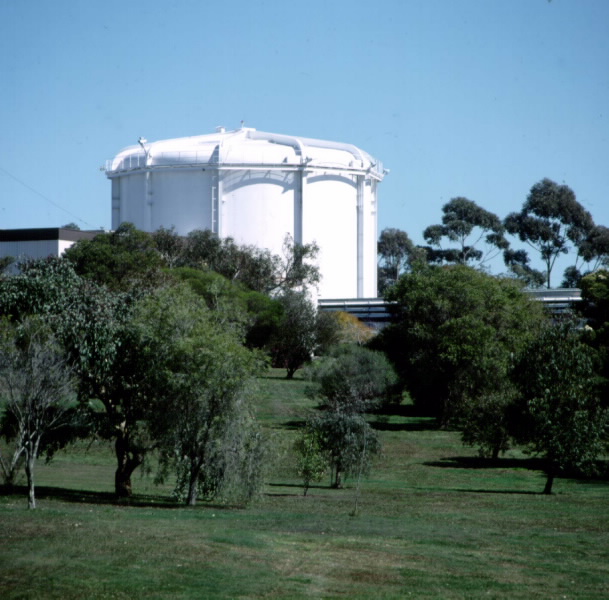 |
| HIFAR |
Australias only nuclear research reactor has reached a landmark in reactor operations: it has begun its 500th operating program.
HIFAR, the High Flux Australian Reactor, first reached achieved nuclear reaction in its core on January 26, 1958, and began routine operations in 1960. HIFAR is a multi-purpose research reactor.
It produces nuclear medicines and industrial isotopes, carries out research into new materials (such as advanced ceramics and polymers), analyses samples for the minerals exploration industry and irradiates silicon for the electronics industry.
It also provides more than 7,000 hours per year in neutron beam time to research scientists and students from Australia and overseas.
Over the years HIFAR has operated on a 28-day cycle: 24 days of routine operation and four days for maintenance and fuel changes. In addition, every five years HIFAR is closed for four months for extended maintenance. The last major shutdown, in 1995, found the reactor to be in good condition.
HIFAR is one of 265 research reactors operating in 59 countries. Another 12 are being built. Its design and operations have proved safe and reliable.
One of six British designed DIDO class reactors built and of three still operating, HIFAR has counterparts of similar age at Julich in Denmark and Karlsruhe in Germany. Both have been significantly refurbished.
Earlier this year, the most extensive safety assessment ever conducted on a research reactor anywhere in the world found that HIFARs, "plant safety status has been shown to be generally good with no evidence of major safety-related problems from its operation."
The independent, 18 month study, was commissioned by the Department of Industry, Science and Tourism, and carried out by a United States consultancy, PLG.
HIFARs management systems received formal acknowledgment in 1997 that they meet international best practice standards. It received formal certification of its Quality Systems as complying with the requirements of AS/NZS ISO 9001.
The ISO 9001 standard, strongly supported by Government and industry in Australia, was developed by the International Standards Organisation in Geneva. It is an internationally recognised quality benchmark.
Research reactors are quite different from power reactors used to generate electricity. HIFAR's nominal maximum thermal power output is 10 megawatts, compared with an average power reactor's 3,000 megawatts. Its total fuel load is only 7 kilograms, while a power reactor may hold up to 190 tonnes of fuel.
The uranium core of HIFAR reactor fits within the imaginary boundaries of a cylinder 80 cms in diameter and 60 cms high (about the same size as a domestic washing machine) located at the centre of the aluminium tank.
HIFAR is probably best known for its role in underpinning Australias nuclear medicine needs. One of the fastest growing fields in modern practice, nuclear medicine has been growing at some 14 per cent a year for the past five years. On current projections, every Australian, on average, can expect a nuclear medicine procedure in their lifetime.
ANSTO is the dominant supplier of reactor-based radiopharmaceuticals, or nuclear medicines, in Australia and is a significant exporter. It will produce more than 430,000 doses of nuclear medicines this year. The first medical radionuclide, sodium-24, was produced in HIFAR in 1960, while cobalt-60 production was the dominant activity from 1961 to 1965.
The radioactive product with the largest annual sales value for ANSTO is the technetium-99m generator. ANSTO began making generators in 1967 and now has about 90 per cent of the Australian market for technetium-99m, the most widely used nuclear medicine. It is used for diagnosing a wide range of cancers and organ functions.
The first export of a radiopharmaceutical manufactured from radioactive material produced in HIFAR took place in 1965/66. The bulk of exports are technetium-99m generators and iodine-131 radiopharmaceuticals, particularly to New Zealand and several countries in Asia.
HIFAR is used for neutron transmutation doping of silicon for industry. Large ingots, each a single crystal of silicon, are inserted into the reactor. There, the neutrons change one atom of silicon in every 1,000 million to phosphorus. Silicon irradiated in HIFAR is returned to silicon suppliers in Japan where it is sliced into wafers and supplied to electronics companies.
In other industrial uses, materials produced in HIFAR are used to accurately gauge thicknesses in high-speed production industries such as paper and plastic film, for tracing pollution in the environment, examining the integrity of crucial welds and structures and helping control insect pests in fruit growing areas.
HIFAR is also used to help analyse samples from minerals and oil exploration. It is a major research tool for ANSTO and other scientists and researchers. Studies of the chemical structures and magnetic properties of materials are made using neutron diffraction or scattering techniques.
They lead to the creation of stronger, lighter, more heat resistant materials for industry, more useful chemicals and advanced pharmaceuticals. In its 40 years of operation, HIFAR has made significant contributions to the well being of Australia, benefiting health, industry and science.


